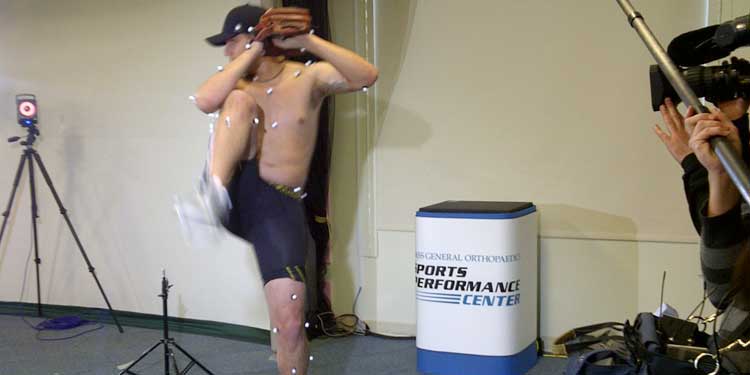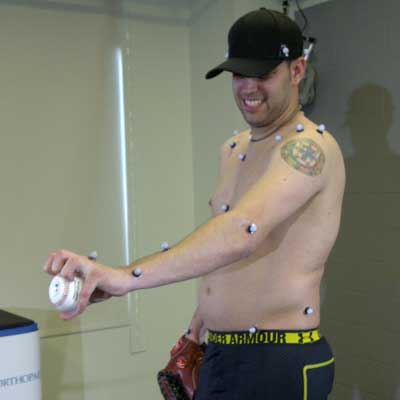The first time I ever saw Tyler Kendrick pitch, he struck out Red Sox infielder Lou Merloni with a knuckleball. Kendrick never would have guessed this would lead to an international documentary airing on the Discovery Channel on Opening Day of the 2013 season, illustrating the science behind throwing a knuckleball.

It all started October of last year. Tyler, a pitcher for the Lexington Blue Sox of the Intercity League, was a participant in the 100 Innings of Baseball annual charity game to raise money for ALS. Red Sox fan favorite, Lou Merloni, was also on hand to support the cause. The stars aligned, and Kendrick struck out Merloni with a knuckleball.
Tyler added color. “I had no idea Lou was going to be at the game. I was just trying to have some fun. After an out, I turned around and was like ‘Whoa, it’s Lou Merloni.’ My catcher called for a knuckleball on a 2-2 count. I said to myself ‘Sure, why not.’ I struck him out. It was one of the greatest moments of my life as a pitcher. Lou and I just started laughing.”
This January, Boston Baseball received an Facebook Message from Dave Litman, a producer for the flagship nightly science program on Discovery Channel in Canada. Litman wrote: “We are planning to do a segment with the Sports Performance Center in Boston, using their biomotion technology to analyze pitchers’ arm motions. We are hoping to get a pitcher who throws a knuckleball as a focus of this segment. Do you happen to know of any pitchers in your league, or in the area, who throw a knuckleball, and would like to participate in this story?”
Boston Baseball sought candidates. Tyler’s teammate, Matt Keough commented on a Facebook post: “Lexington Blue Sox Tyler Kendrick !!” Tyler’s name, photo, and biography was then submitted to the Discovery Channel with two other local baseballers. Tyler was their top choice. Litman said: “I’m most interested in Tyler, with his younger arm.”
Tyler, who turned 23 this April, grew up in Montague, MA, went to school in Smith Academy in Hatfield, and played with Team USA when he was 18. He then moved on to pitch for Fitchburg State University. His collegiate career was cut short when he tore his elbow and missed the next two seasons from Tommy John surgery. None of this stopped him from playing, and he’s been with the Blue Sox ever since.
This March, Tyler headed to the Mass General Orthopaedic Sports Performance Center in Foxborough to have his knuckleball video analyzed for the world to see on the Discovery Channel. The segment initially ran in Canada, immediately before R.A. Dickey’s Opening Day start for the Toronto Blue Jays, before airing stateside.
I asked Tyler what was involved with the filming. “There were 18 cameras on me so they could monitor exactly where my body was going and the speed of my arms and body. They stretched me out for 30 minutes just to see how flexible I was. And they spent another 20 minutes affixing 62 of these 3D markers to my body that the cameras could detect. The markers keep coming off my foot since I drag my foot when I pitch. It probably took an hour to throw a 30-pitch bullpen. There were like 5 or 6 people there on computers analyzing everything, and Dr. Eric Berkson, the team physician for the Boston Red Sox, was even there, and he came in after he saw the results from my session.”

I asked Tyler what he thought would be discovered. “I didn’t really think there was going to be that much to show. But I was wrong. I had been told to throw half knuckleballs and half fastballs, and one thing shocked me. I have a high leg kick and a long stride. When I throw a knuckleball, it feels like my leg kick isn’t as high. But once I saw the videos, I saw I had an identical motion. The only thing that was different was that on my fastball, my arm came through a little bit faster, but you could barely tell.
My fastball had 25% more torque than my knuckleball. It is amazing that a Major Leaguer can throw so much longer in their career just by using 25% less torque. When I throw a knuckleball, I don’t even feel it.”
Tyler told me that historically, he doesn’t even use his knuckleball that often, but this experience will change his pitching approach. “I threw it less because I figured batters would catch on right away. So I’d kind of mess around with it, and maybe use it if I’m up in a game. As a result of what I learned from the analysis, I’m going to throw the knuckleball a lot more this year. I’m becoming more confident with it, and it’s going to break a lot more.”
Tyler also learned that the knuckleball might be a pitch that kids should spend more time learning. “For the younger guys, the knuckleball is a very effective pitch. The hardest part is staying with it, and working to perfect it, but your arm will love you for it – even if you don’t throw hard. If you have a successful knuckleball, you never know where you might go. For younger kids, just play around with it when you’re playing catch. One day it may click. You never know where your future may lead you.”
Tyler commented on what it was like to see himself on TV on Opening Day. “I was in Chicago for work, and I didn’t see it until that Wednesday. A colleague and I watched it on my computer. It just was unbelievable. It shows me just as dots, then turns me unto a skeleton, and then I look like a video game character. It was crazy. To see myself on TV was pretty weird.”
Yet, this chapter in Tyler’s life isn’t over. “In a couple weeks, I get to go back to the Sports Performance Center, and they are going to do a full month-long analysis, so they can really go into detail on my pitching mechanics. It was hard to them make predictions so quickly for the television show. It normally costs a lot of money for what they are doing for me on my pitching, and I get to do it for free.”
Tyler concluded: “When the knuckleball is on, it’s the funnest thing of all time.”
Brett Rudy is a trailblazer in the world of baseball. As the founder of Baseball Is My Life and co-founder of Charity Hop Sports Marketing, he’s dedicated to elevating the sport and supporting the athletes who play it. With a passion for making a difference, Brett has created successful philanthropic initiatives like Charity Wines and 100 Innings of Baseball for ALS. He’s also the mastermind behind the Corked Bat Collection, Cooperstown Classic at the Baseball Hall of Fame, and Winterball for Toys for Tots. When he’s not working to improve the game, Brett can be found playing outfield in the Boston Metro Baseball League, living and breathing the sport he loves.